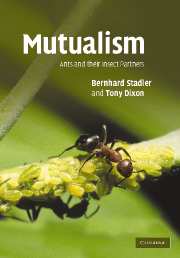2 - Historical perspective
Published online by Cambridge University Press: 13 August 2009
Summary
Compared with competition and exploitation (predation and parasitism) mutualism has been very little studied by field and theoretical ecologists. In 1986 May and Seger recorded that the ratio of papers on competition:exploitation:mutualism published in ecological journals was 4:4:1 and in terms of pages devoted to these subjects in ecological textbooks it was 5:6:1, and this marked prevalence of publications and pages in textbooks on competition and exploitation over that devoted to mutualism still prevails (Fig. 2.1).
This is surprising since a vast number of mutualistic relationships, many of which are still incompletely described, are known from nature, for example: pollinating insects, symbiotic micro-algae in corals etc., and symbiotic nitrogen-fixing bacteria. Besides these, which are fundamental for the functioning of organisms, there are many more exotic examples, for example cleaning symbioses of coral fish, associations of hermit crabs with sea anemones and luminescent bacteria with fish and cephalopods.
It is suggested that the gender bias in science may have encouraged a male view of life as a contest, ‘like a football game’ (Diamond 1978). However, there has not been a noticeable change in emphasis in this respect associated with the dramatic change in the sex ratio among biologists, as least in western societies, which has occurred since 1978. More recently Turchin (2003) suggested that more attention is devoted to competition and exploitation than mutualism because such interactions appear to be more important for population dynamics.
- Type
- Chapter
- Information
- MutualismAnts and their Insect Partners, pp. 9 - 13Publisher: Cambridge University PressPrint publication year: 2008



